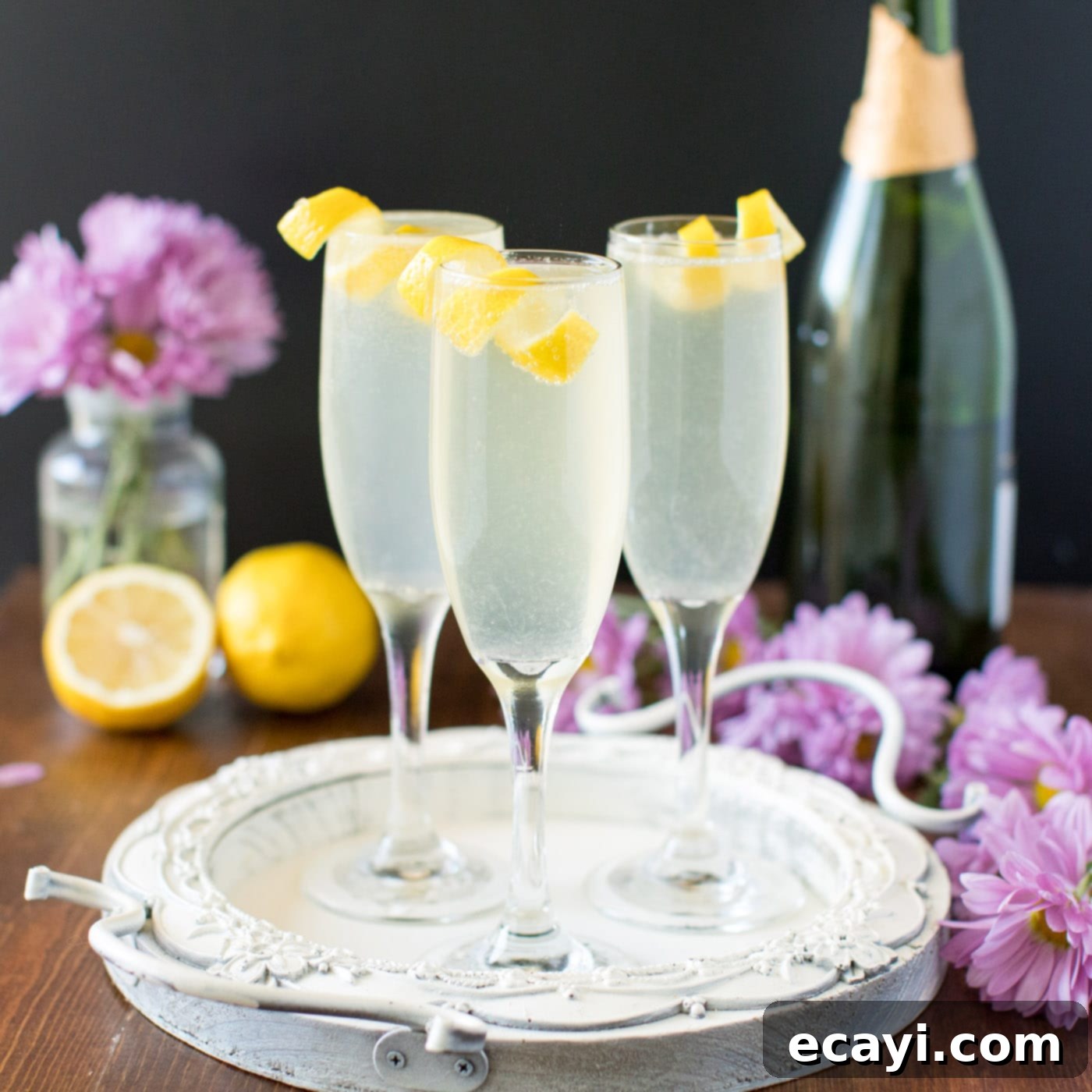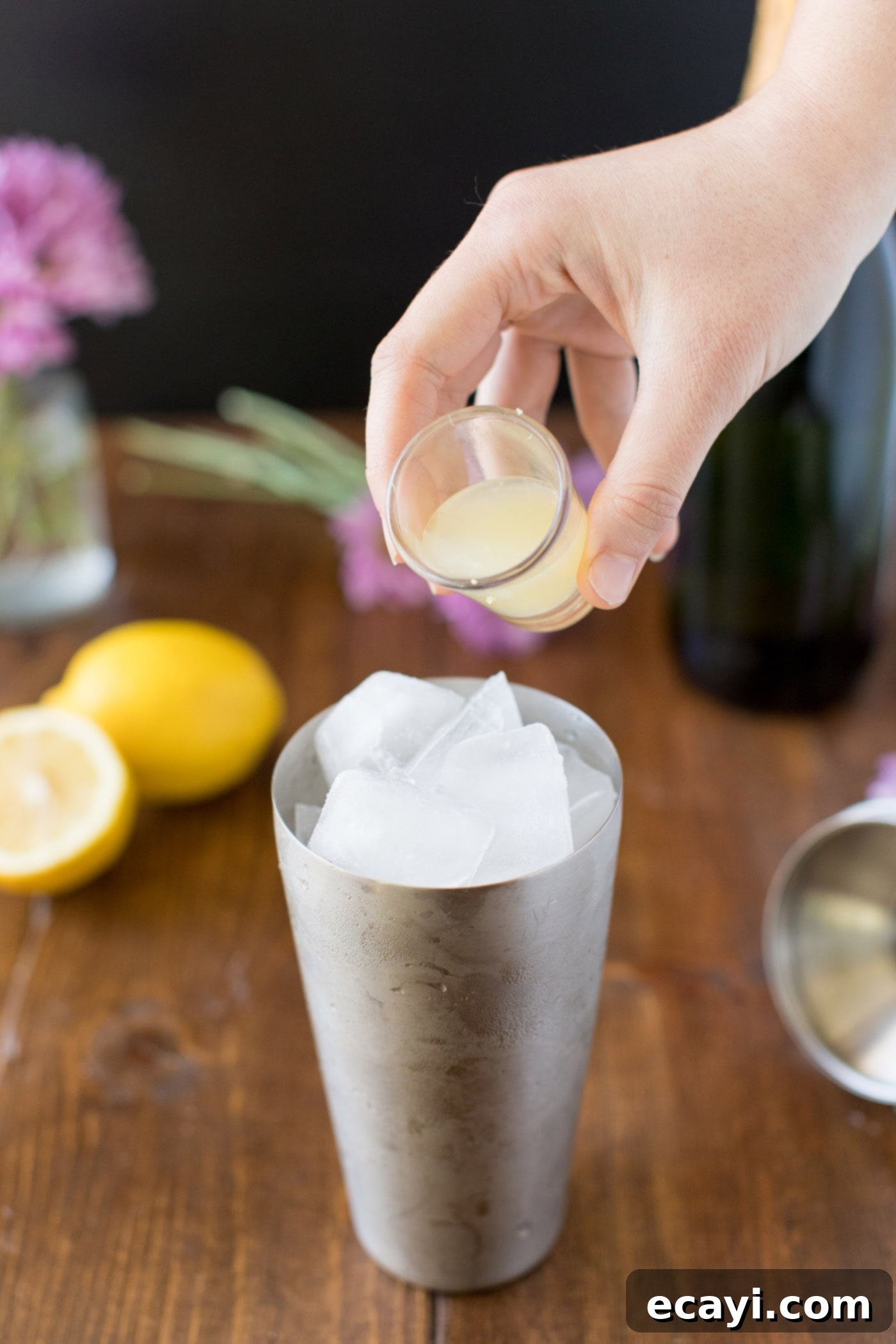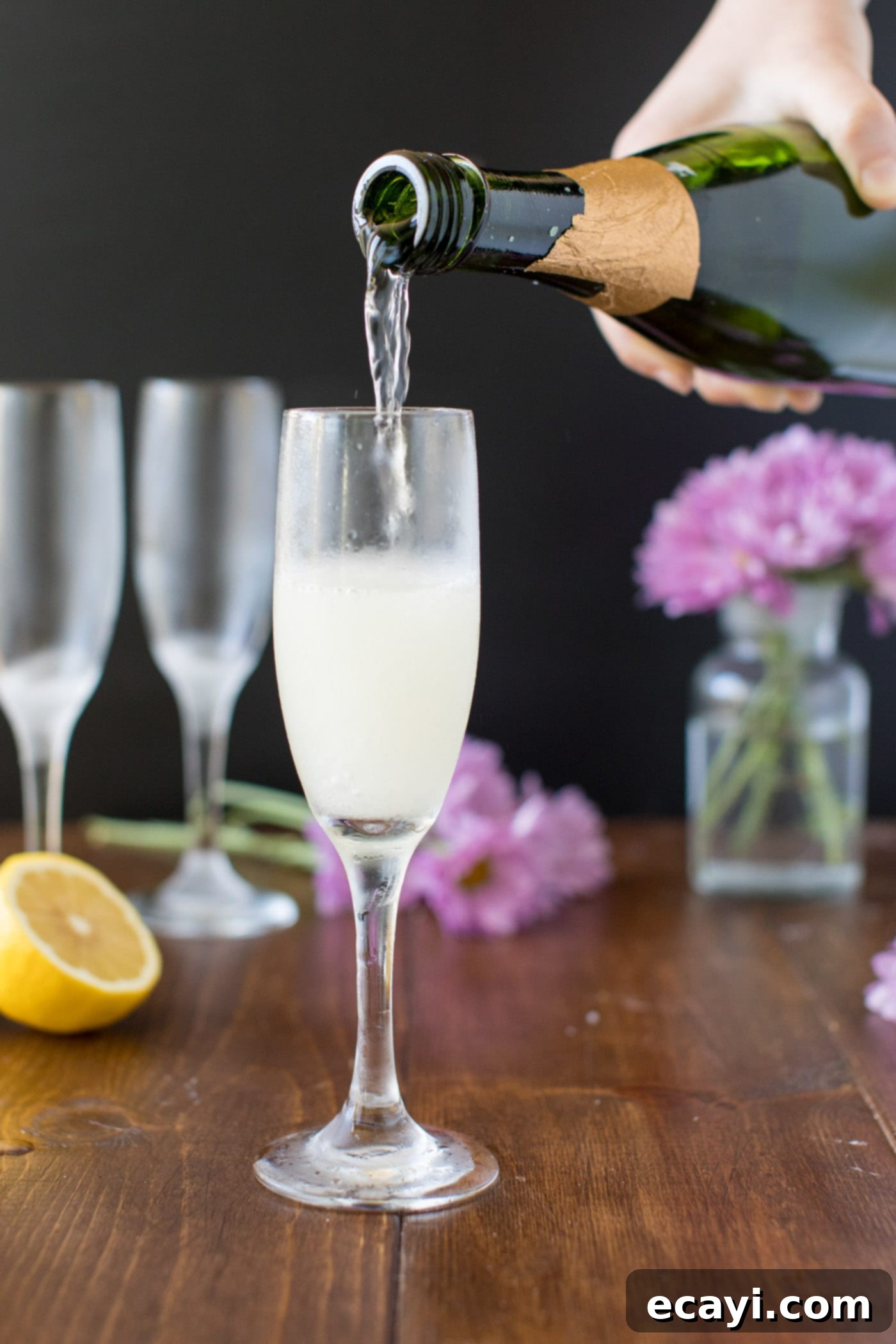Classic French 75 Cocktail: The Ultimate Gin and Champagne Recipe for Any Celebration
The French 75 is an iconic, effervescent cocktail, celebrated for its refreshing zest and elegant sparkle. It’s an impeccable choice for a variety of occasions, from sophisticated brunches and joyous wedding receptions to festive holiday gatherings. Often likened to a luxurious, “spiked bubbly lemonade,” this timeless drink effortlessly captures the essence of summer, offering a bright and invigorating experience with every sip. Its perfect balance of botanicals, citrus, and bubbles makes it a delightful treat year-round, embodying both sophistication and vibrant freshness.
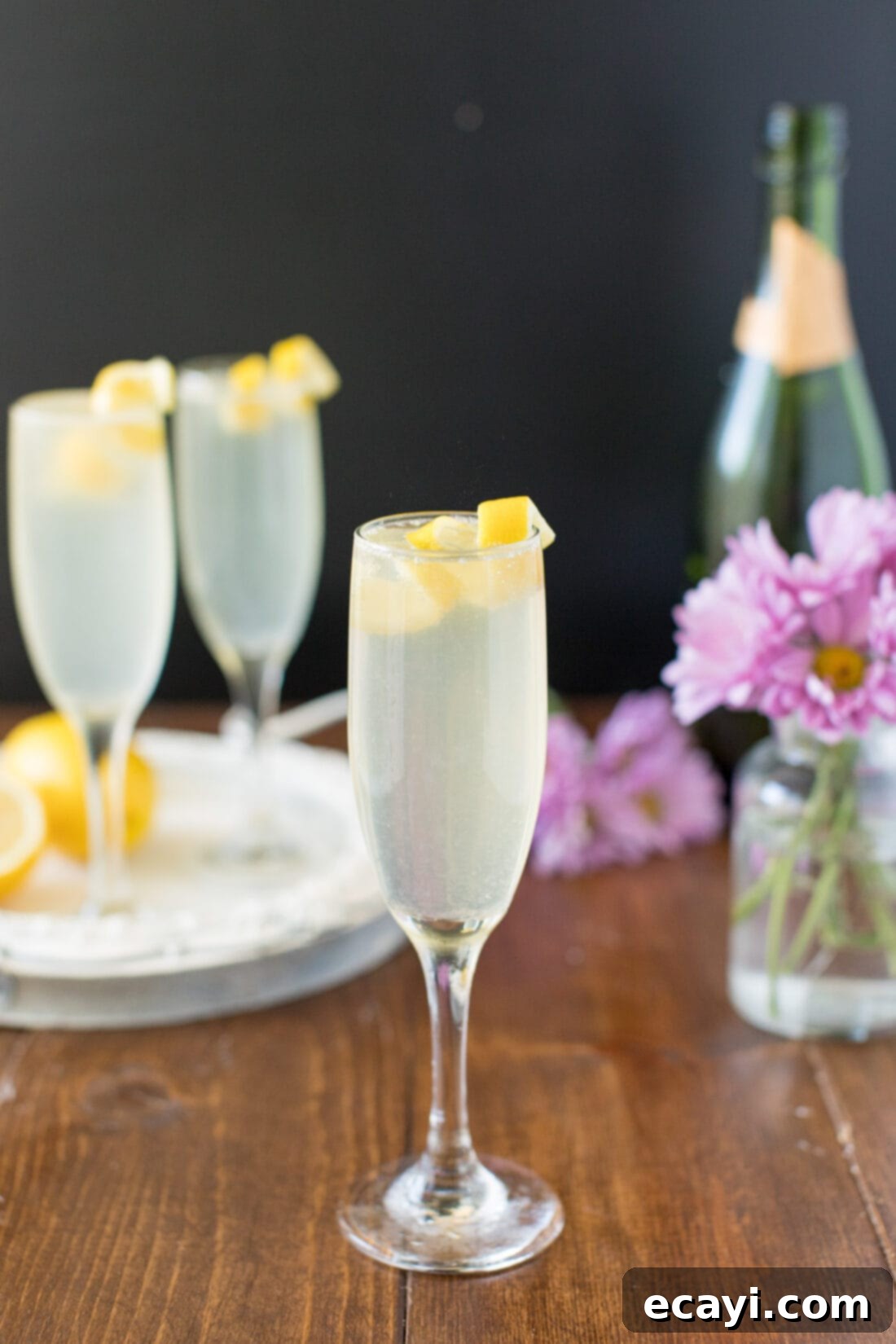
Why This French 75 Recipe Is a Must-Try
Our French 75 recipe stands out for its elegant simplicity and perfectly balanced flavors, offering a lighter, more vibrant alternative to heavier brunch cocktails like the traditional mimosa. This celebratory drink relies on just four core ingredients: premium London dry gin, freshly squeezed lemon juice, homemade simple syrup, and crisp Brut champagne. Each component plays a crucial role in creating a harmonious, exhilarating profile that is both complex and incredibly easy to enjoy.
The gin provides a botanical backbone, adding depth without overpowering the delicate citrus and sparkling wine. Fresh lemon juice is non-negotiable here, as its bright acidity is key to cutting through the sweetness and enhancing the overall refreshing quality. Simple syrup ensures a smooth, consistent sweetness that blends seamlessly, unlike granulated sugar which can be gritty. Finally, the Brut champagne lends its dry, effervescent charm, elevating the drink with a sophisticated fizz that makes every occasion feel special. Traditionally served in a tall, elegant champagne flute, this cocktail is an ideal accompaniment to any brunch spread, whether it’s for Easter, Mother’s Day, or a casual summer get-together. Its bright, bubbly nature makes it an instant crowd-pleaser and a sophisticated addition to your entertaining repertoire.
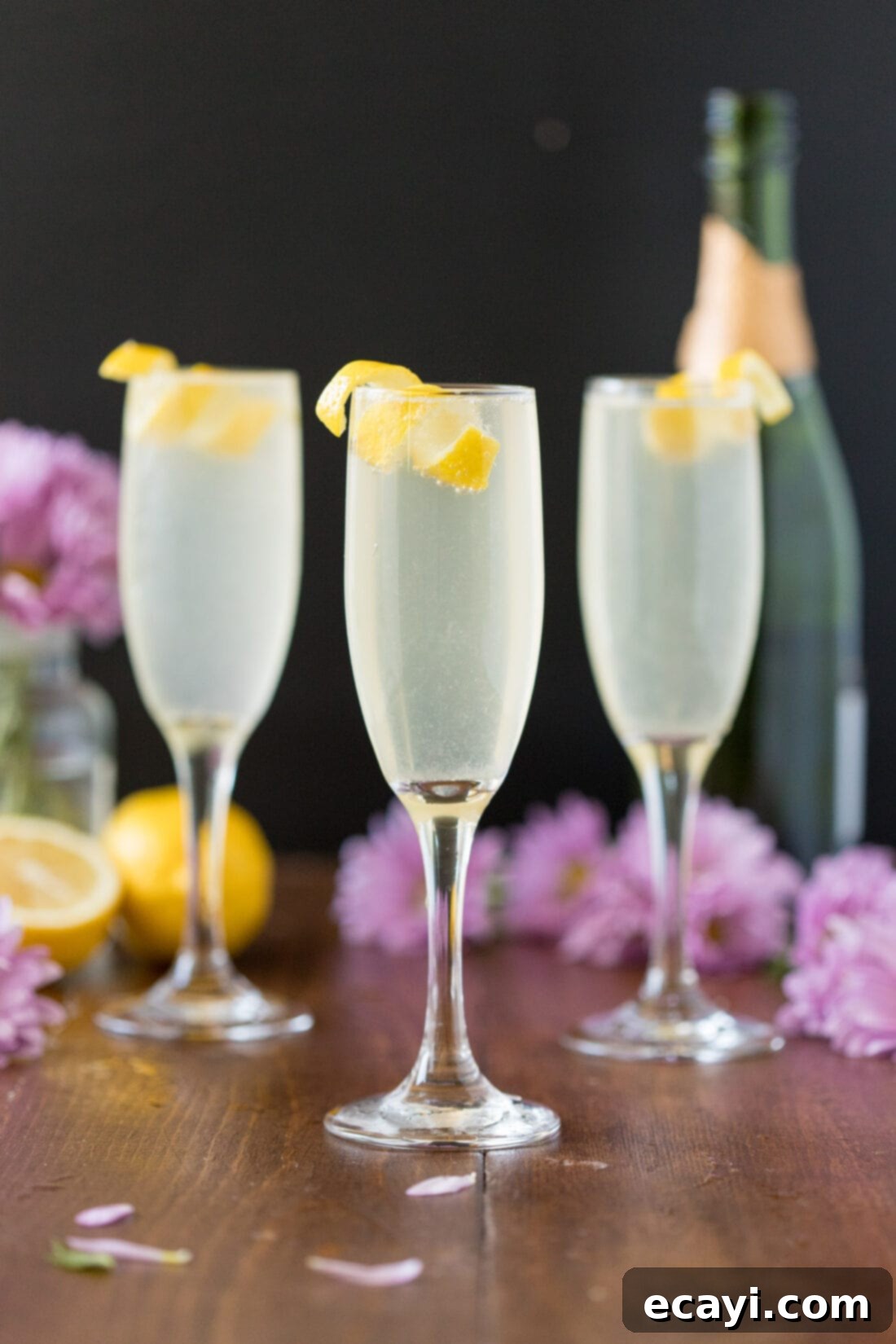
Essential Ingredients for Your Perfect French 75
Crafting a stellar French 75 requires a commitment to quality ingredients, especially when there are so few of them. Each component contributes significantly to the cocktail’s final taste and effervescence. You’ll find all precise measurements, ingredient details, and comprehensive instructions in the printable recipe card located at the end of this post. Here’s a closer look at what you’ll need:
- London Dry Gin: This type of gin is critical for the classic French 75. Its crisp, juniper-forward profile provides the perfect botanical foundation without being overly floral or sweet. Brands like Tanqueray, Beefeater, or Bombay Sapphire are excellent choices, offering the clean, aromatic notes necessary for this cocktail.
- Fresh Squeezed Lemon Juice: The importance of using fresh lemon juice cannot be overstated. Bottled lemon juice often contains preservatives and lacks the bright, vibrant acidity and aroma that truly makes this cocktail shine. Aim for organic lemons if possible, and always squeeze them just before mixing for the freshest flavor.
- Simple Syrup: This sweet component balances the tartness of the lemon juice. Simple syrup is merely a 1:1 mixture of sugar and water, heated until the sugar dissolves, then cooled. You can easily make it at home in minutes. It integrates far better into cold drinks than granulated sugar, ensuring a smooth, evenly sweetened cocktail.
- Brut Champagne: “Brut” signifies a dry champagne, meaning it has very little residual sugar. This dryness is crucial for complementing the other ingredients without making the drink overly sweet. Quality champagne is recommended, but you can also use other dry sparkling wines like Cava or Prosecco (look for “Brut” on the label) for a delicious, slightly more budget-friendly option.
- Lemon Peel Twist for Garnish: Not just for aesthetics, a lemon peel twist adds an aromatic finish to your French 75. The oils released from the zest when twisted over the drink contribute a subtle, fragrant layer that enhances the entire sensory experience.
Step-by-Step Guide: How to Craft a Classic French 75
Creating this elegant cocktail is surprisingly simple, yet the steps are important for achieving the perfect balance and presentation. Follow these instructions carefully to make a French 75 that’s sure to impress:
- Prepare Your Garnish: Using a sharp paring knife or a zester, carefully slice a long, continuous peel from a fresh lemon. Aim for a spiral shape, going all the way around the fruit if possible. This long strip will be used to create an elegant twist.
- Combine Ingredients in Shaker: Fill a cocktail shaker about two-thirds full with fresh ice. Add your measured London dry gin, freshly squeezed lemon juice, and simple syrup. The ice is crucial for chilling and slightly diluting the mixture to perfection.

- Shake Vigorously: Secure the lid on your cocktail shaker and shake vigorously for approximately 20 seconds. This ensures that the gin, lemon juice, and simple syrup are thoroughly chilled and perfectly blended. You should feel the shaker become very cold in your hands.
- Strain and Top with Champagne: Strain the chilled mixture directly into a pre-chilled champagne flute. Chilling your flute beforehand (by placing it in the freezer for a few minutes or filling it with ice water and discarding) helps keep your drink colder for longer. Gently top the strained mixture with cold Brut champagne, pouring slowly to preserve the delicate bubbles.

- Create the Lemon Twist: Take the long lemon peel you prepared earlier. Curl it around the handle of a wooden spoon, a cocktail stirrer, or even your finger to create a beautiful, elegant spiral twist.
- Garnish and Serve: Place the lemon twist artfully into your French 75. Serve immediately to enjoy the peak effervescence and crisp, refreshing flavors.
Expert Tips for the Best French 75:
- Chill Everything: Always use chilled gin, lemon juice, simple syrup, and especially champagne. A well-chilled drink tastes infinitely better and will hold its bubbles longer.
- Freshness is Key: We’ve said it before, but it bears repeating: use freshly squeezed lemon juice. There’s simply no substitute.
- Measure Accurately: Cocktails are a science. Use a jigger or measuring spoons to ensure precise ratios for a balanced drink.
- Don’t Over-Shake: While vigorous shaking is good for chilling, over-shaking can over-dilute. 20 seconds is usually sufficient.
- Gentle Pour for Champagne: When adding the champagne, tilt the flute slightly and pour slowly down the side to minimize foam and preserve maximum carbonation.
- Batching for Parties: For larger gatherings, you can pre-mix the gin, lemon juice, and simple syrup ahead of time and store it in the refrigerator. When ready to serve, simply shake with ice, strain, and top with chilled champagne in each flute.
The Fascinating History Behind the French 75 Cocktail
The name “French 75” is steeped in history, particularly from the dramatic backdrop of World War I. While some may know it simply as a “75 Cocktail” or, translated from French, a “Soixante-Quinze,” its origins are far more evocative than a simple number. Legend has it that the cocktail was first concocted in 1915 by a clever barman named Harry MacElhone at the New York Bar in Paris (which later became Harry’s New York Bar). The name wasn’t random; it was inspired by patrons who remarked that the potent combination packed a punch so strong it felt akin to being hit by a French 75mm field gun – a powerful piece of artillery widely used during the war.
Like many classic cocktails, the French 75 recipe has seen several transformations over the decades. Harry MacElhone’s initial rendition was quite different from what we enjoy today, reputedly featuring Calvados, gin, grenadine, and absinthe. The version we recognize as the classic French 75 began to solidify with the publication of the 1927 book “Here’s How” by Judge Jr., which documented the recipe containing gin, lemon, sugar, and champagne, firmly establishing its place in cocktail lore. Interestingly, some other notable mixology books and contemporary variations occasionally replace gin with Cognac, offering a different, often richer, flavor profile while still retaining the “French” spirit of the drink.
Beyond its wartime origins, the French 75 has enjoyed a prominent presence in popular culture. Film buffs will likely recall its mention in the iconic 1942 film “Casablanca,” adding a touch of old-world glamour to the bubbly concoction. It also appeared in two of legendary actor John Wayne’s films during the 1940s and 1950s, further cementing its status as a sophisticated drink of choice. More recently, in 2016, the French 75 made an appearance in the popular British historical drama series “Mr. Selfridge,” demonstrating its enduring appeal and timeless elegance across generations and media. It’s truly a cocktail with a story, making each sip a taste of history and cinematic charm.
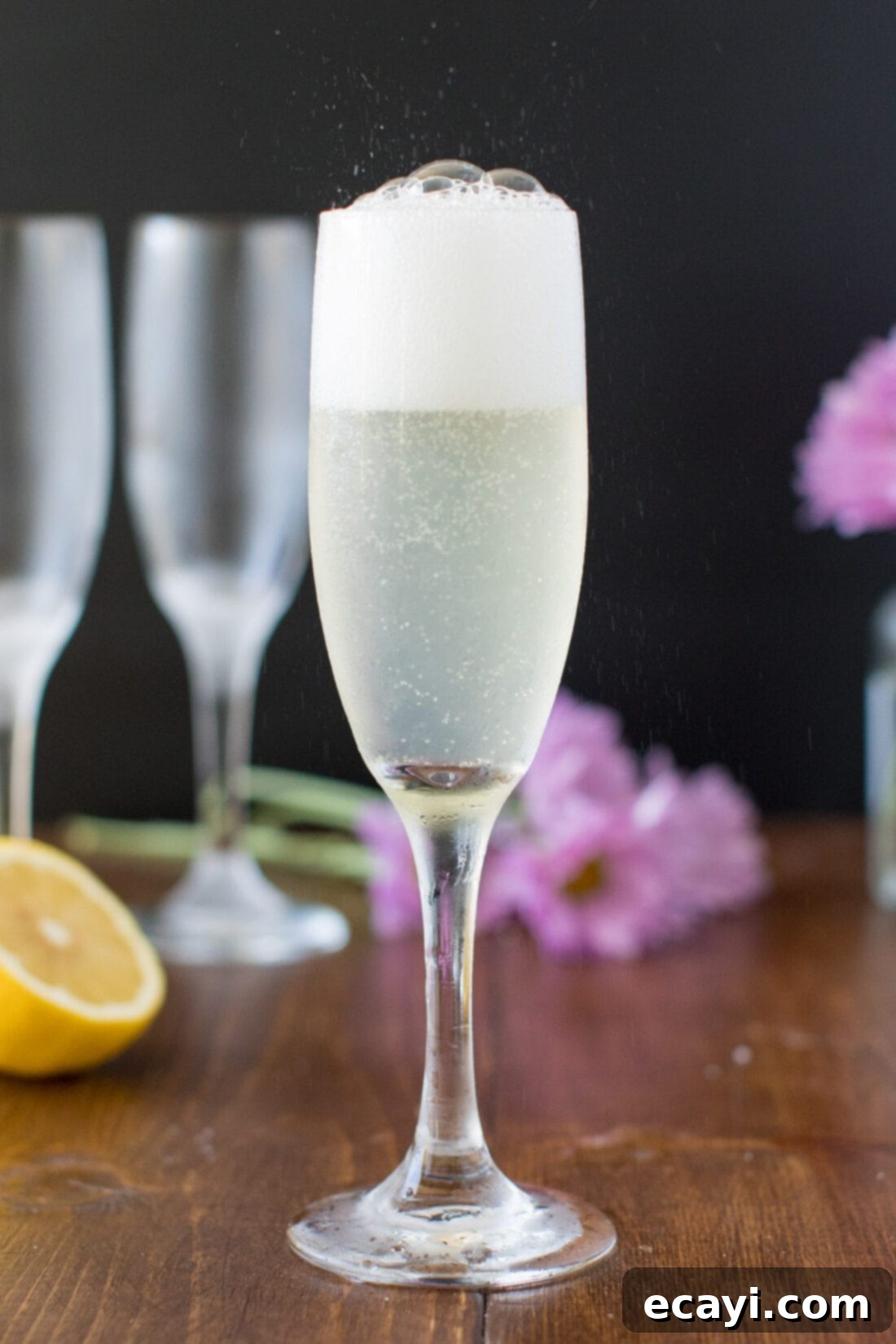
We sincerely hope you thoroughly enjoy creating and savoring your very own French 75 cocktail! It’s more than just a drink; it’s a piece of history and a celebration in a glass.
Explore Cocktails Similar to the French 75
If you’re a fan of the French 75’s crisp, refreshing, and slightly botanical profile, you’ll likely appreciate other classic cocktails that share similar characteristics or ingredients. Here are a few recommendations that offer delightful alternatives or extensions to your cocktail repertoire:
- Gimlet Cocktail: A quintessential gin-based drink, the Gimlet shares the French 75’s reliance on London dry gin and fresh citrus. Instead of lemon, it features freshly squeezed lime juice, often balanced with simple syrup or, traditionally, Rose’s Lime Juice. Served in a coupe glass, it’s a testament to how simple ingredients can create profound flavors. Its tart, botanical profile makes it a delightful cousin to the French 75.
- Tom Collins: This long, refreshing drink is incredibly similar to the French 75, but with a key difference: it swaps the champagne for carbonated water or club soda. Composed of gin, lemon juice, simple syrup, and topped with soda, the Tom Collins offers a less celebratory but equally refreshing experience, often served in a tall Collins glass. It’s a fantastic everyday alternative when you crave the gin and lemon combination without the champagne.
- Lemon Drop Cocktail: If the lemony brightness of the French 75 is what you love most, the Lemon Drop is a must-try. This cocktail switches out gin for vodka and adds a touch of triple sec for an orange liqueur sweetness, alongside fresh squeezed lemon juice and simple syrup. Shaken with ice and strained into a sugar-rimmed martini glass, it’s a sweet, tart, and potent drink that’s perfect for those who enjoy a vibrant citrus kick.
- Lynchburg Lemonade: For a summertime favorite that evokes a similar “spiked lemonade” vibe as the French 75, look no further than the Lynchburg Lemonade. This Southern-inspired cocktail combines Jack Daniel’s whiskey with triple sec, fresh lemon juice, and a splash of lemon-lime soda. Named after Lynchburg, Tennessee, the home of the Jack Daniel’s distillery, it offers a whiskey-forward alternative that is equally refreshing and perfect for warm weather.
Frequently Asked Questions About the French 75
What type of gin is best for a French 75?
For a classic French 75, London Dry Gin is highly recommended. Its crisp, juniper-forward, and often citrusy notes complement the lemon and champagne beautifully. Brands like Tanqueray, Beefeater, or Bombay Sapphire are excellent choices, but feel free to experiment with your favorite quality London Dry. Some people also enjoy an Old Tom gin for a slightly sweeter, softer botanical profile.
Can I use Prosecco or Cava instead of Champagne?
Absolutely! While traditionally made with Champagne, dry Prosecco (look for “Brut” or “Extra Dry”) or Cava are excellent and often more budget-friendly alternatives. They will still provide the delightful effervescence and dryness needed for a fantastic French 75. Just ensure they are dry (Brut) to maintain the cocktail’s balanced sweetness.
How do I make simple syrup at home?
Making simple syrup is incredibly easy and much better than using granulated sugar. Combine equal parts granulated sugar and water in a saucepan (e.g., 1 cup sugar, 1 cup water). Heat over medium heat, stirring constantly, until the sugar completely dissolves. Do not boil. Remove from heat and let it cool completely before using. Store any leftover simple syrup in an airtight container in the refrigerator for up to a month.
Can I make a batch of French 75 ahead of time for a party?
Yes, you can prepare a component of the French 75 in advance. Mix the gin, fresh lemon juice, and simple syrup together in a pitcher and chill it in the refrigerator for up to 24 hours. When you’re ready to serve, pour the chilled mixture into a cocktail shaker with ice, shake briefly to chill further, strain into champagne flutes, and top with very cold champagne just before serving. Do not add the champagne to the batch mixture ahead of time, as it will lose its effervescence.
What food pairs well with a French 75?
The French 75 is incredibly versatile. Its bright, crisp, and refreshing profile pairs wonderfully with a variety of foods, especially those served at brunch or light appetizers. Think light seafood dishes like oysters or shrimp cocktails, smoked salmon, delicate cheeses, fruit tarts, quiches, or even fried chicken. Its acidity cuts through richness and cleanses the palate, making it an excellent companion to many culinary delights.
Are there any variations to the classic French 75?
Yes, many! You can experiment with different types of gin (floral, herbaceous, or even barrel-aged for a richer taste). Try using a flavored simple syrup (lavender, rosemary, or ginger) for an aromatic twist. Some recipes call for Cognac instead of gin for a “French 75 Royal.” You can also experiment with different garnishes like a lemon wheel, a few fresh berries, or a sprig of mint.
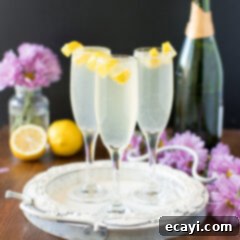
French 75 Cocktail
IMPORTANT – There are often Frequently Asked Questions within the blog post that you may find helpful. Simply scroll back up to read them!
Print It
Pin It
Rate It
Save ItSaved!
Ingredients
- 1 oz London dry gin
- ½ oz fresh lemon juice
- ½ oz simple syrup
- Ice
- 3 oz Brut champagne
- Lemon peel twist for garnish
Things You’ll Need
-
Paring knife or zester
-
Cocktail shaker
-
Champagne flutes
Instructions
-
Using a paring knife or a zester, slice peel from lemon, going all the way around to create a long spiral.
-
Fill cocktail shaker with ice. Add gin, lemon juice, and simple syrup. Shake vigorously for 20 seconds.
-
Strain into chilled champagne flute and top with Brut.
-
Curl lemon peel around a wooden spoon or your finger to create a long twist.
-
Garnish drink with twist and serve immediately.
Nutrition
The recipes on this blog are tested with a conventional gas oven and gas stovetop. It’s important to note that some ovens, especially as they age, can cook and bake inconsistently. Using an inexpensive oven thermometer can assure you that your oven is truly heating to the proper temperature. If you use a toaster oven or countertop oven, please keep in mind that they may not distribute heat the same as a conventional full sized oven and you may need to adjust your cooking/baking times. In the case of recipes made with a pressure cooker, air fryer, slow cooker, or other appliance, a link to the appliances we use is listed within each respective recipe. For baking recipes where measurements are given by weight, please note that results may not be the same if cups are used instead, and we can’t guarantee success with that method.
This post was originally published on March 16, 2019, and has since been updated and expanded to provide you with the most comprehensive guide to the French 75 cocktail.
